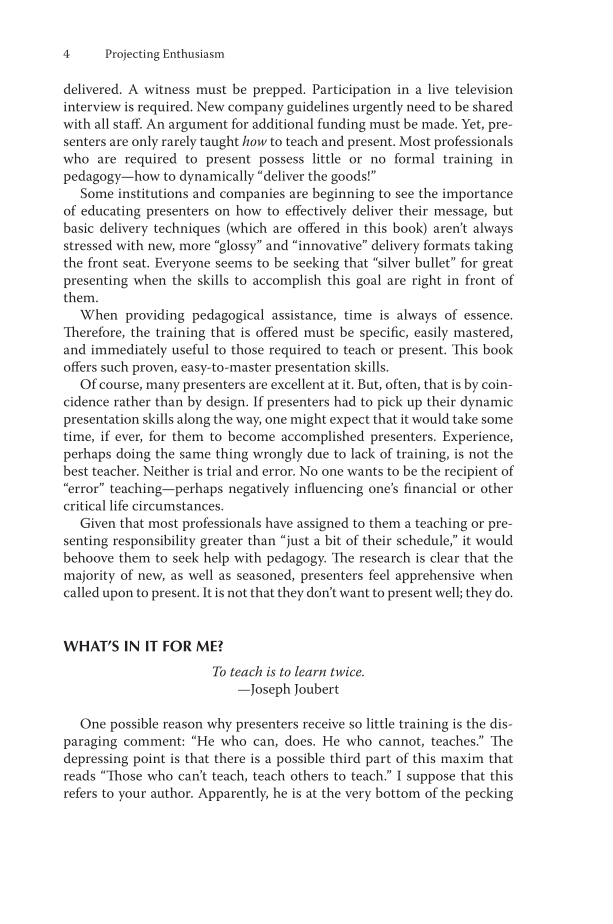4 Projecting Enthusiasm delivered. A witness must be prepped. Participation in a live television interview is required. New company guidelines urgently need to be shared with all staff. An argument for additional funding must be made. Yet, pre- senters are only rarely taught how to teach and present. Most professionals who are required to present possess little or no formal training in pedagogy—how to dynamically “deliver the goods!” Some institutions and companies are beginning to see the importance of educating presenters on how to effectively deliver their message, but basic delivery techniques (which are offered in this book) aren’t always stressed with new, more “glossy” and “innovative” delivery formats taking the front seat. Everyone seems to be seeking that “silver bullet” for great presenting when the skills to accomplish this goal are right in front of them. When providing pedagogical assistance, time is always of essence. Therefore, the training that is offered must be specific, easily mastered, and immediately useful to those required to teach or present. This book offers such proven, easy-to-master presentation skills. Of course, many presenters are excellent at it. But, often, that is by coin- cidence rather than by design. If presenters had to pick up their dynamic presentation skills along the way, one might expect that it would take some time, if ever, for them to become accomplished presenters. Experience, perhaps doing the same thing wrongly due to lack of training, is not the best teacher. Neither is trial and error. No one wants to be the recipient of “error” teaching—perhaps negatively influencing one’s financial or other critical life circumstances. Given that most professionals have assigned to them a teaching or pre- senting responsibility greater than “just a bit of their schedule,” it would behoove them to seek help with pedagogy. The research is clear that the majority of new, as well as seasoned, presenters feel apprehensive when called upon to present. It is not that they don’t want to present well they do. WHAT’S IN IT FOR ME? To teach is to learn twice. —Joseph Joubert One possible reason why presenters receive so little training is the dis- paraging comment: “He who can, does. He who cannot, teaches.” The depressing point is that there is a possible third part of this maxim that reads “Those who can’t teach, teach others to teach.” I suppose that this refers to your author. Apparently, he is at the very bottom of the pecking
Document Details My Account Print multiple pages
Print
You have printed 0 times in the last 24 hours.
Your print count will reset on at .
You may print 0 more time(s) before then.
You may print a maximum of 0 pages at a time.


























































































































































































































